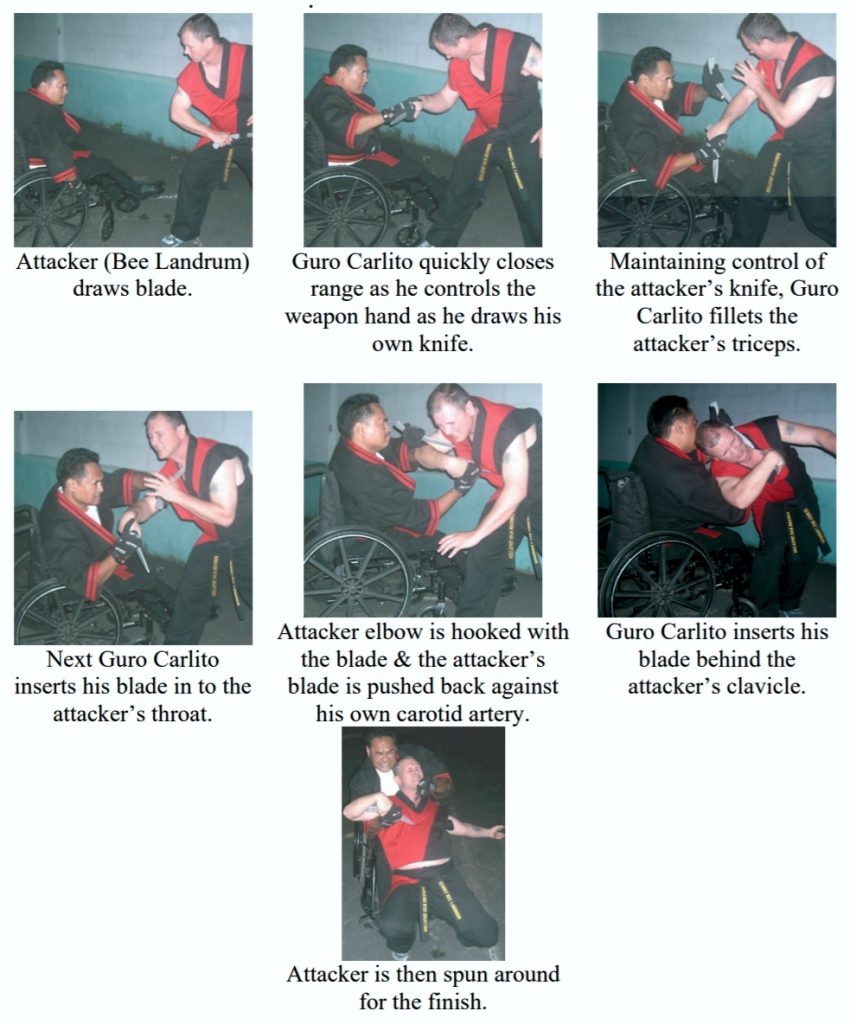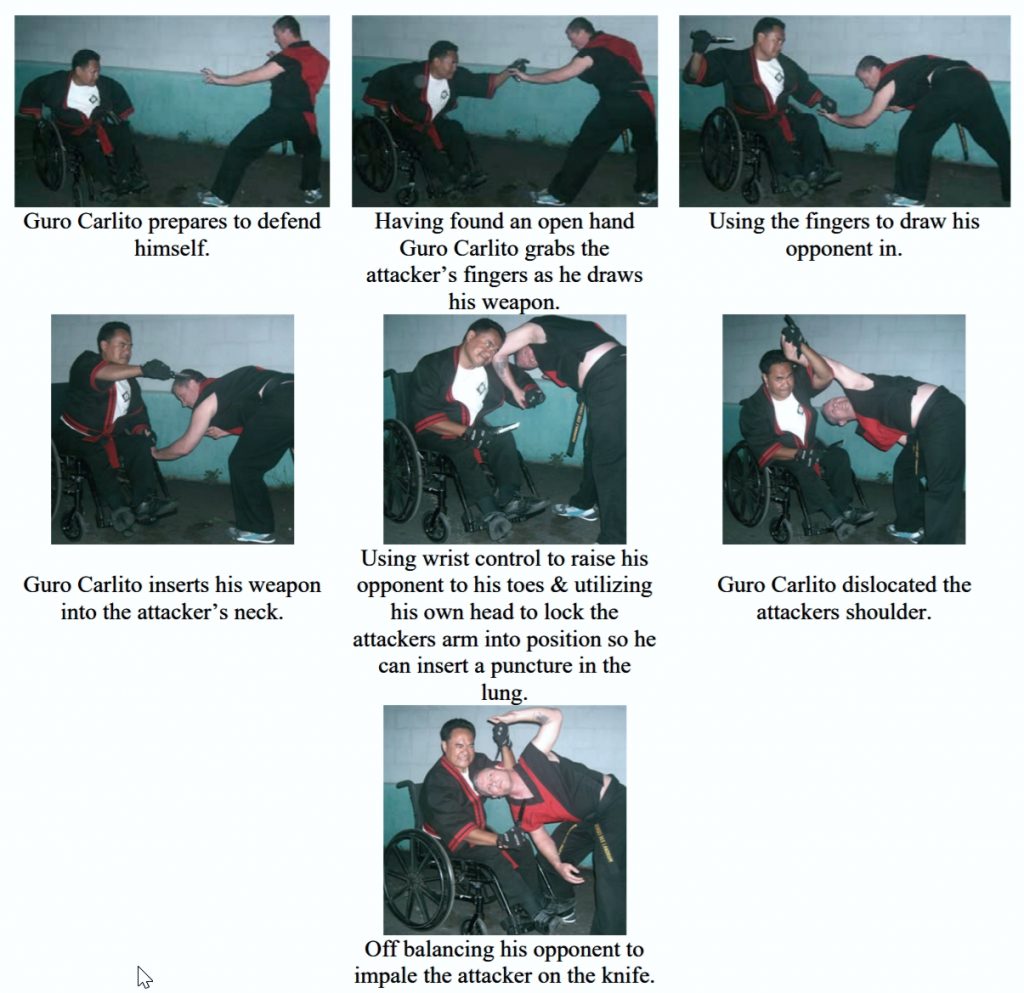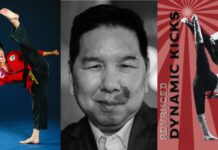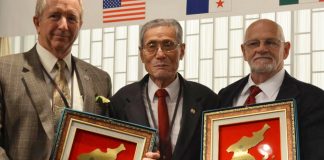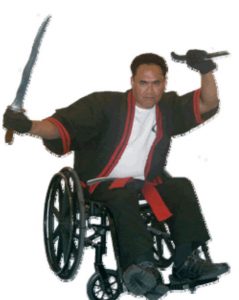 At first glance, Carlito is a very unassuming individual, always ready with a good word and a smile that can light up a room. He walks on crutches or uses a wheelchair due to Spinal Bifida and a leg amputation, he tells the story of why his leg was amputated like this: Being from south Stockton, California is very dangerous.
At first glance, Carlito is a very unassuming individual, always ready with a good word and a smile that can light up a room. He walks on crutches or uses a wheelchair due to Spinal Bifida and a leg amputation, he tells the story of why his leg was amputated like this: Being from south Stockton, California is very dangerous.
One day I (Carlito) was getting out of my car and something grabbed my leg and started dragging me. I looked down, and saw a dog holding my leg in his teeth (he was really locked on), I screamed for help, but no one came. So I started punching the dog as hard as I could but he wouldn’t let go.
He was one of those vicious dogs, and people listening would shout, “PIT BULL, DOBERMAN, ROTT WEILLER!” He would respond with, “No it was that other vicious dog…a CHIHUAHA!” People would stare in disbelief and then start laughing like crazy. Carlito is always ready with a joke.
This is the kind of light-hearted person Carlito is. Underneath this jovial kind hearted charismatic personality, beats the heart of a true warrior.
One who has overcome both physical and emotional battles that no one would wish to endure. Carlito Bonjoc is a very knowledgeable and capable Escrimador, despite his limitations… He spends countless hours studying and teaching in Stockton, Roseville and around the world.
On June 20th 2006 I had the honor and privilege to interview this interesting character. Guro Carlito Bonjoc Jr. started training at the age of 10 years old. He studied 3 Filipino martial arts styles:
- Talawan escrima, under Grandmaster Roy Onor
- Cadiz Lapu-Lapu escrima, under Grandmaster Carlito Bonjoc Sr.
- Cabales Serrada escrima, under Grandmaster Angel Cabales
Guro Carlito Bonjoc: You’re welcome Bee, it’s my pleasure.
BL: Can you please tell us how you got started.
CB: My parents moved us from the Philippines to Stockton, CA USA when I was about 10 years old. Being new to this country I spoke differently, dressed differently, and walked with a limp due to Spinal Bifida so I stood out like a sore thumb. I was like a nose, easy to pick on.
The other children would chase me and hit me knowing I couldn’t run away. At the end of the day I would cry to my older sister Bernadette. My sister started training with my father when she was about six or seven years old in the grappling aspect of my fathers style.
When I was that age I wanted to learn escrima too, but my father felt I didn’t have the proper temperament yet so he would not train me yet. With all of the stuff that was happening in school it was tough for my sister to see me crying almost daily so she begged my father to start teaching me.
 I was always taught not to fight by my parents, they wanted me to be able to talk my way out of a bad situation. I never had a lot of problems with kids in the Philippines, but it was different here. Especially at the school I attended. The kids here were much tougher.
I was always taught not to fight by my parents, they wanted me to be able to talk my way out of a bad situation. I never had a lot of problems with kids in the Philippines, but it was different here. Especially at the school I attended. The kids here were much tougher.
You see, this was the poor side of town, South Stockton. This was the type of neighborhood where if you showed any type of weakness they would take advantage of it. There was this one particular kid that used to bully me. We were low-income, my parents were farm laborers and my sister and I used to get free lunch tickets.
After I’d get my free lunch that one kid would come take my food out of my lunch tray. On other occasions he would take my lunch money and beat me up just for good measure.
My sister explained all of this to my dad and he felt it was time for me to start training. This is when I started with my dad’s friend, Master Roy Onor. Manong (address of respect to elders) Roy had an informal class in his backyard with three kids that would train on the weekends during the warm season.
I was lucky because my family was living in Manong Roy’s house so on days when there was no school I would get extra training. He started me off with Filipino boxing, it was a little different because you could throw elbows, knees, head butts, and eye gouges. In other words, dirty fighting.
He never took it easy on me. I remember him pinning me to the wall and having to fight my way out. On the weekends when the other kids were there he would have us go into his backyard and we would practice with sticks.
He would tell us to pretend that our sticks were blades. His style (Talawan System) was very offensive. Everything was direct hitting with specific targets in mind before the kill like slicing the legs, resulting in the opponent hitting the ground, and then you are ready to finish him.
BL: Guro Carlito, can you tell us what the word Talawan means?
CB: This was style that was geared against multiple opponents. The word Talawan in the Visayan dialect means afraid. Manong Roy was from the Island of Bohol.
He said that most of the fighters from this part of the Philippines like to fight at close range but the Talawan fighters prefer to hit and move because you had to position yourself so that you are never caught between two people.
By using strategy and creative footwork you give yourself a higher possibility of escape. That’s why the Escrimadors called them Talawan (afraid). Now we use the name proudly.
BL: Can you tell us about your Father and Cadiz Lapu-Lapu.
CB: At the time I trained with Manong Roy my father was trying to train me too. My father was trained by my grandfather and he in turn was trained by his father. So I am 4th generation to continue this tradition. So this style of Escrima (Cadiz Lapu-Lapu) is based on the double stick drills and using techniques with the Kris sword in mind.
At medium to close range using bare hands we employ; punching, kicking, elbows, knees, throws, head-butts and joint manipulation. In Manokan, Zamboanga del Norte, Philippines my father has a great reputation as a no holds barred fighter with just one loss after many fights.
Although he was a great fighter he was not a good teacher for me. Maybe because I was his son he didn’t just have the patience to tolerate my hard headedness. When I couldn’t get things right he would loose his patience and he didn’t like yelling at me so he would just walk away.
This is why he had me train with Manong Roy and later on with Manong Angle Cabales. After getting the bulk of my foundation from these great masters it was only then that I began to understand my Dad’s unorganized training method. Now we had a great time; no more yelling!
BL: Training with the legendary Angel Cabales; please can you share with our readers your experience with him?
CB: Besides being the great fighter that he was Grandmaster Cabales was an excellent instructor. Without sacrificing the combative concepts of Serrada he would use his student’s natural tendencies to tailor their training so they can utilize those natural tendencies to a greater advantage.
After observing me training some of the students, Manong Angel told me that with proper guidance I could also become a good instructor. I’m glad that he felt this way because when my doctor told me that I might loose my leg.
We knew that this was the only way I was going to be able to participate in this art. This is when Manong Angel seriously trained me specifically to be a teacher. For this I can never give him enough thanks.
BL: What makes you a better teacher and why should someone come to you instead of someone who has full use of his legs?
CB: Well Bee, I don’t claim or think I’m the best around, but I do feel that I do have an understanding that others might not. Not all, but most instructors base their teaching approach on the way that they would fight. Having physical dexterity, strength & quickness they would train their students as if they were equal in those traits.
As for me I’ve always had to compensate, adapt and overcome or cheat if I had to. I rely more on proper techniques, both traditional and creative ones in order to win. This is what I share with my students. By relying on these principles, physical dexterity is an added bonus to the technique.
BL: Guro Carlito, again I would like to thank you for taking time out of your busy schedule to share with us your thoughts and experience.
CB: Thank you Bee, it was my pleasure, please leave a check under the mat.
By Bee Landrum
Originally Published in FMA Digest Volume 4, 2007


